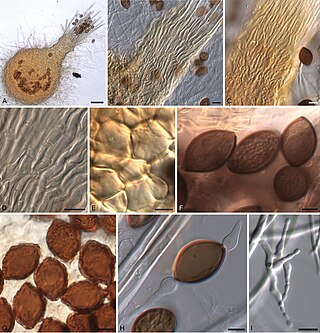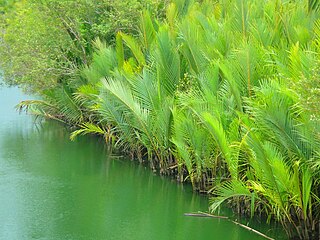Related Research Articles

The Pleosporales is the largest order in the fungal class Dothideomycetes. By a 2008 estimate, it contained 23 families, 332 genera and more than 4700 species. The majority of species are saprobes on decaying plant material in fresh water, marine, or terrestrial environments, but several species are also associated with living plants as parasites, epiphytes or endophytes. The best studied species cause plant diseases on important agricultural crops e.g. Cochliobolus heterostrophus, causing southern corn leaf blight on maize, Phaeosphaeria nodorum causing glume blotch on wheat and Leptosphaeria maculans causing a stem canker on cabbage crops (Brassica). Some species of Pleosporales occur on animal dung, and a small number occur as lichens and rock-inhabiting fungi.
The Halosphaeriaceae are a family of fungi in the Sordariomycetes class, subclass Hypocreomycetidae. Halosphaeriaceae is the family with the largest number of marine fungi with a few species are from freshwater and terrestrial habitats.
Aniptodera is a genus of fungi in the Halosphaeriaceae family. The genus contained nine species in 2008, by 2023 it had increased to 19 species.
Neptunella is a fungal genus in the family Halosphaeriaceae. It is a monotypic genus, containing the single species Neptunella longirostris, described as new to science in 1956.
Nautosphaeria is a genus of fungi in the family Halosphaeriaceae. This is a monotypic genus, containing the single species Nautosphaeria cristaminuta, which was found on submerged wood.
Salsuginea is a genus of fungi in the class Dothideomycetes. The relationship of this taxon to other taxa within the class was unknown in 2007. Until Kevin D. Hyde & Tibpromma, 2013 introduced family Salsugineaceae within the order of Pleosporales.
The Trichosphaeriales are an order of sac fungi. It is monotypic, and consists of the single family, the Trichosphaeriaceae. In 2017, the family of Trichosphaeriaceae was placed in Diaporthomycetidae families incertae sedis, which was accepted by Wijayawardene et al. (2018), and Wijayawardene et al. 2020. The order of Trichosphaeriales was also unplaced. They are generally saprobic and pathogenic on plants, commonly isolated from herbivore dung.
Conioscyphascus is a fungal genus in the Sordariomycetes class of the Ascomycota. The relationship of this taxon to other taxa within the class is unknown, and it has not yet been placed with certainty into any order or family. The genus, Conioscyphascus contains the single species Conioscyphascus varius, described as new to science in 2004. Until Conioscyphascus gracilis(Munk) Réblová & Seifert was found later in 2004.
The Lulworthiaceae are a family of marine fungi in the Ascomycota, class Sordariomycetes. Species in the family have a widespread distribution in both temperate and tropical oceans, and are typically found growing on submerged wood or on seaweed. In 2000, Molecular analysis of several species of Lulworthia and Lindra led to the reassignment of their parent genera to the new order Lulworthiales in addition to the new family Lulworthiaceae. In 2020, a large fungi study added more genera to the family.

Melanospora is a genus of fungi within the Ceratostomataceae family.

Nypa fruticans, commonly known as the nipa palm or mangrove palm, is a species of palm native to the coastlines and estuarine habitats of the Indian and Pacific Oceans. It is the only palm considered adapted to the mangrove biome. The genus Nypa and the subfamily Nypoideae are monotypic taxa because this species is their only member.

Bertia is a genus of fungi within the Bertiaceae family, and Hypocreomycetidae subclass.
Fuscosporellales is an order of fungi within the phylum of Ascomycota and in the class Sordariomycetes and subdivision of Pezizomycotina.
Savoryellaceae is a family of aquatic based fungi. It is the only family in the monotypic order Savoryellales within the class Sordariomycetes, division Ascomycota.
Savoryella is a genus of freshwater and marine based fungi in the family Savoryellaceae and the order Savoryellales.

The Torpedosporales are an order of marine based fungi in the class Sordariomycetes, subclass Hypocreomycetidae. Most are found on wood substrates in the water.
Etheirophoraceae is a family of ascomycetous marine based fungi within the order of Torpedosporales in the subclass Hypocreomycetidae and within the class Sordariomycetes. They are saprobic on intertidal wood and bark within marine habitats.

Juncigenaceae is a family of ascomycetous marine based fungi within the order of Torpedosporales in the subclass Hypocreomycetidae and within the class Sordariomycetes. They are saprobic to intertidal wood, within mangrove forests and other herbaceous wood and roots, bark, leaves in various marine habitats.
Torpedosporaceae is a monotypic family of ascomycetous marine based fungi within the order of Torpedosporales in the subclass Hypocreomycetidae and within the class Sordariomycetes. They are saprobic on intertidal mangrove wood and roots, bark leaves, and sand in various marine habitats.
Falcocladium is a genus of fungi, within the monotypic family FalcocladiaceaeSomrith., E.B.G. Jones & K.L. Pang, and within the monotypic order FalcocladialesR.H. Perera, Maharachch., Somrith., Suetrong & K.D. Hyde, within the class Dothideomycetes. They are saprobic on leaf litter, including the leaves of Eucalyptus grandis and Eucalyptus camaldulensis in tropical and terrestrial habitats.
References
- ↑ Lumbsch TH, Huhndorf SM. (December 2007). "Outline of Ascomycota – 2007". Myconet. 13. Chicago, USA: The Field Museum, Department of Botany: 1–58.
- 1 2 Suetrong, S.; Klaysuban, A.; Sakayaroj, J.; Preedanon, S.; Ruang-Areerate, P.; Phongpaichit, S.; Pang, K.L.; Jones, E.B.G. (2015). "Tirisporellaceae, a New Family in the Order Diaporthales (Sordariomycetes, Ascomycota)". Cryptogamie, Mycologie. 36 (3): 319–330.
- ↑ Jones, E.B.G.; Hyde, Kevin D.; Read, S.J.; Moss, S.T.; Alias, S.A. (1996). "Tirisporella gen. nov., an ascomycete from the mangrove palm Nypa fruticans". Canadian Journal of Botany. 74: 1487–1495.
- ↑ Jones, E.B.G.; Suetrong, S.; Sakayaroj, J.; Bahkali, A.H.; Abdel-Wahab, M.A.; Boekhout, T.; Pang, K.L. (2015). "An updated classification of marine Ascomycota, Basidiomycota, Blastocladiomycota and Chytridiomycota". Fungal Diversity. 73: 1–72.